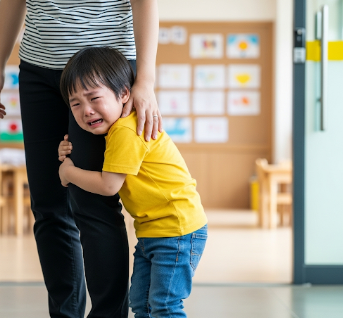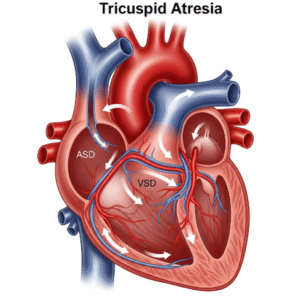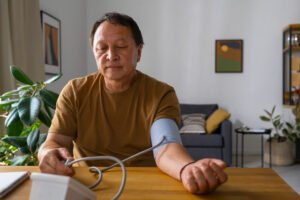➤ Overview
Separation anxiety is a psychological condition where an individual experiences excessive fear or distress when separated from a person or place to which they are emotionally attached. While it is common in children, it can also affect adolescents and adults.
In South Korea, separation anxiety is recognized as a treatable mental health condition, and early evaluation by psychologists, psychiatrists, or pediatricians can help prevent long-term emotional or social difficulties. Effective management improves daily functioning, social interactions, and overall quality of life.
➤ Key Facts
→ Separation anxiety is most common in children aged 6–10, but can persist into adulthood.
→ It is considered a normal developmental stage in young children but becomes concerning when excessive or prolonged.
→ Early intervention helps prevent academic, social, and emotional complications.
→ Symptoms may be behavioral, emotional, or physical.
→ In Korea, treatment includes psychotherapy, family support, and, in some cases, medication.
→ Untreated separation anxiety can increase risk of depression, generalized anxiety, or panic disorders.
→ Family involvement and supportive school environments are crucial for recovery.
➤ What is Separation Anxiety?
Separation anxiety is the intense fear or distress experienced when anticipating or undergoing separation from a primary attachment figure:
→ Developmental separation anxiety – Normal in infants and toddlers; usually resolves with age.
→ Pathological separation anxiety – Persistent, excessive, and disruptive beyond developmental norms.
→ Adult separation anxiety – Anxiety about being apart from loved ones, home, or familiar surroundings.
→ School refusal – A common manifestation in children with separation anxiety.
→ Attachment-related anxiety – Strong emotional dependence on parents or caregivers.
In Korea, mental health professionals assess severity, duration, triggers, and functional impairment to diagnose separation anxiety accurately.
➤ What Symptoms are Related to Separation Anxiety?
Symptoms can be emotional, behavioral, and physical:
→ Excessive worry about losing loved ones.
→ Fear of being alone or sleeping away from home.
→ Crying, tantrums, or clinginess in children.
→ Reluctance or refusal to go to school, work, or social events.
→ Nightmares or sleep disturbances related to separation.
→ Physical complaints – Headaches, stomachaches, nausea, or rapid heartbeat.
→ Irritability or tantrums when separation is imminent.
→ Excessive reassurance-seeking from caregivers.
→ Difficulty concentrating in school or work due to anxiety.
→ Avoidance behaviors – Avoiding activities that may require separation.
➤ What Causes / Possible Causes?
Separation anxiety may arise from genetic, psychological, and environmental factors:
→ Genetic predisposition – Family history of anxiety or mood disorders.
→ Temperamental factors – High sensitivity, shyness, or cautious personality.
→ Attachment issues – Insecure attachment to primary caregivers.
→ Major life events – Divorce, relocation, hospitalization, or parental absence.
→ Parenting style – Overprotective or inconsistent caregiving.
→ Traumatic experiences – Loss of loved one or exposure to stressful events.
→ Environmental stressors – School pressures, bullying, or peer conflicts.
→ Medical conditions – Chronic illness in child or caregiver increasing worry.
→ Cultural factors – Expectations regarding family dependence and independence in Korean society.
➤ When Should I See My Doctor?
Medical or psychological consultation is recommended if symptoms are persistent, severe, or interfering with daily life:
→ Separation anxiety lasting longer than 4 weeks in children or affecting adults chronically.
→ Severe emotional distress when anticipating separation.
→ School refusal or work absenteeism due to fear of separation.
→ Physical symptoms like stomachaches, headaches, or panic attacks related to separation.
→ Sleep disturbances or nightmares affecting daily functioning.
→ Avoidance behaviors limiting social or educational activities.
→ Symptoms causing distress to family members or caregivers.
→ No improvement with reassurance or minor interventions.
Early evaluation in Korea ensures access to evidence-based therapy and support systems.
➤ Care and Treatment
Treatment focuses on reducing anxiety, building coping skills, and promoting independence:
→ Cognitive Behavioral Therapy (CBT) – Teaches coping strategies and challenges anxious thoughts.
→ Exposure therapy – Gradual and structured separation experiences to reduce fear.
→ Family therapy – Helps caregivers support the child and modify interaction patterns.
→ Parent training – Encourages consistent routines and supportive independence.
→ Relaxation techniques – Mindfulness, breathing exercises, or guided imagery.
→ School collaboration – Supportive teachers, modified schedules, and gradual reintegration.
→ Medication – Occasionally prescribed for severe anxiety, under psychiatric supervision.
→ Support groups – Peer interaction and sharing experiences to reduce isolation.
➤ Treatment Options in Korea
South Korea offers comprehensive mental health care for separation anxiety across age groups:
Diagnosis in Korea
→ Clinical assessment – Structured interviews with child, parents, or adult patient.
→ Behavioral observation – Assess response to separation situations.
→ Standardized questionnaires – Evaluate severity and functional impairment.
→ Medical evaluation – Rule out physical causes of anxiety-related symptoms.
Medical Treatments in Korea
→ Psychotherapy – Individual or group CBT, play therapy for children.
→ Family-based interventions – Educating parents on effective coping and support strategies.
→ Medication – Selective serotonin reuptake inhibitors (SSRIs) for severe cases.
Advanced Therapies in Korea
→ Integrated care programs – Combining therapy, school support, and family guidance.
→ Behavioral modification programs – For children struggling with school or social activities.
→ Teletherapy – Accessible counseling and therapy via online platforms.
Rehabilitation & Support in Korea
→ Education on symptom recognition, coping strategies, and gradual independence.
→ Regular follow-up to monitor progress, adjust therapy, and prevent relapse.
→ Collaboration with schools, community centers, and pediatric or psychiatric clinics for holistic care.













